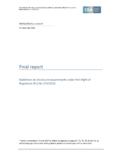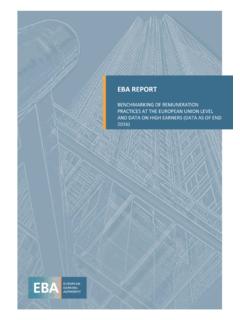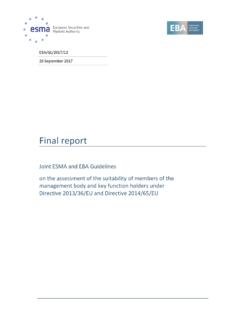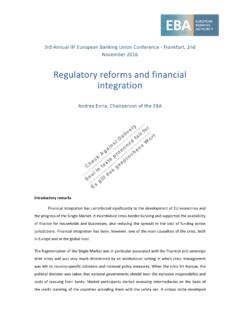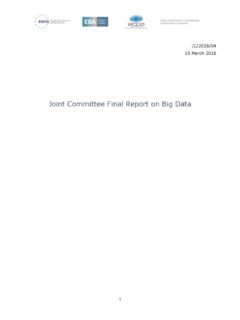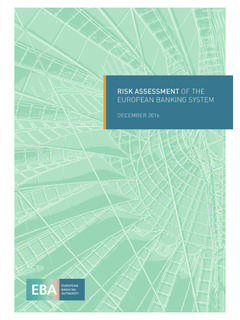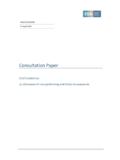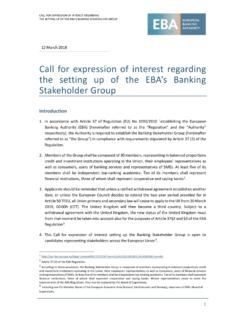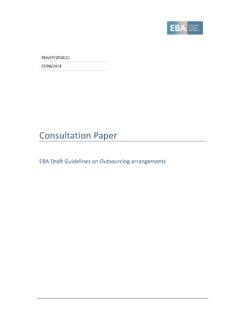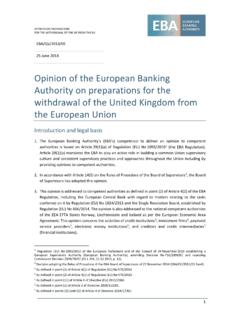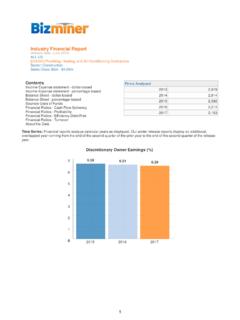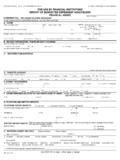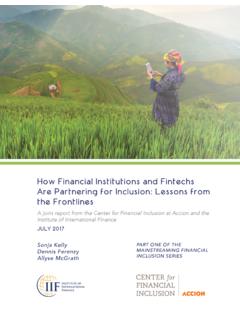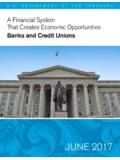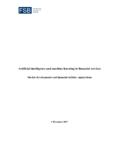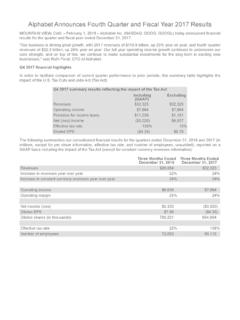Transcription of EBA FINANCIAL EDUCATION REPORT 2017/18
1 EBA FINANCIAL EDUCATION REPORT 2017/18 EBA FINANCIAL EDUCATION REPORT 2017/18 2 Contents Executive summary 3 Introduction 4 1. Scope of the REPORT 5 2. The EBA repository 6 3. Educational approaches used by national supervisory authorities 7 Subject matter 7 Format 8 Target group 9 Output produced 10 4. Lessons learned from FINANCIAL EDUCATION initiatives 11 Identification of FINANCIAL EDUCATION needs 12 Design and implementation of initiatives 13 Assessment of the success of initiatives 16 Selected types of initiatives in focus 17 Annex: EBA repository 22 EBA FINANCIAL EDUCATION REPORT 2017/18 3 Executive summary One of the mandates conferred on the European Banking Authority (EBA) is to review and coordinate FINANCIAL literacy and EDUCATION initiatives by the competent authorities . The EBA s FINANCIAL EDUCATION REPORT (hereafter the REPORT ) represents the EBA s first publication in fulfilment of this mandate.
2 To fulfil its remit, the EBA started to collate national EDUCATION initiatives and store them in an EBA internal repository available to national authorities to inform themselves of the work done by other authorities. However, during 2017, the EBA arrived at the view that it would be of added value to assess the initiatives in the repository, learn valuable lessons and make this assessment public via a REPORT . The REPORT is based on the EBA repository, which consists of 84 FINANCIAL EDUCATION initiatives that were taken by the national authorities responsible for supervising the FINANCIAL services and products that are within the EBA s scope of action (hereafter national supervisory authorities or NSAs), primarily during 2016 and 2017. The REPORT is focused on initiatives in respect of products that fall within the scope of action of the EBA s consumer protection mandate, or broad-scope initiatives that have some link to the EBA s scope of action.
3 The REPORT presents a general view of the most common approaches used by the NSAs as reported in the initiatives collated in the repository. To this end, it focuses on four key characteristics of the initiatives: subject matter, format, target group and type of output produced. The REPORT also sets out NSAs insights into FINANCIAL EDUCATION by presenting the lessons learned and experiences gained by NSAs when carrying out the FINANCIAL EDUCATION initiatives included in the EBA repository. Lessons learned are organised following a possible sequential process of developing and implementing FINANCIAL EDUCATION initiatives, and include lessons learned in the identification of FINANCIAL EDUCATION needs, in the design and implementation of the initiatives, and in the assessment of the success of the initiatives.
4 In addition, and taking a different perspective, the REPORT provides some insights expressed by NSAs in relation to some specific initiatives, such as initiatives aimed at consumers in general and initiatives for school students. Finally, the annex reproduces the EBA repository, which consists of all 84 initiatives submitted by the NSAs. EBA FINANCIAL EDUCATION REPORT 2017/18 4 Introduction 1. One of the mandates conferred on the EBA is to review and coordinate FINANCIAL literacy and EDUCATION initiatives by the competent authorities as laid down in Article 9(1)(b) of the EBA Founding The objective of the EBA mandate on FINANCIAL EDUCATION , in contrast to other tasks and objectives given to the EBA in its Founding Regulation, is less aimed at harmonisation and convergence across the 28 European Union (EU) Member States; rather, the focus is on reviewing the initiatives carried out by NSAs.
5 The different nature of this mandate is appropriate, as it reflects the divergence in scope and depth of the EDUCATION remits of the NSAs across the 28 EU Member States. 2. To fulfil its remit, the EBA started to collate national EDUCATION initiatives and store them in an EBA internal repository available to national authorities to inform themselves of the work done by other authorities. However, during 2017, the EBA arrived at the view that it would be of added value to assess the initiatives in the repository, learn valuable lessons and make this assessment public via a REPORT . 3. The EBA s FINANCIAL EDUCATION REPORT (hereafter the REPORT ) is the result of this reflection and represents the EBA s first publication in fulfilment of this mandate. It is based on a repository of 84 FINANCIAL EDUCATION initiatives that were taken by NSAs primarily during 2016 and 2017.
6 The REPORT provides an opportunity for other national or international organisations interested in FINANCIAL EDUCATION to learn about, and possibly build on, the work carried out by NSAs across the 28 EU Member States. 4. The REPORT is split into four chapters. Chapter 1 sets out its scope in the context of the wording of the EBA mandate on FINANCIAL literacy and EDUCATION and the general regulatory remit of the EBA. Chapter 2 presents the methodology used to collate the initiatives for an EBA repository as an integral part, and the basis, of the REPORT . 5. Chapter 3 summarises the most common educational approaches taken by the NSAs based on the information collated in the EBA repository. It does so by reviewing four key characteristics of the initiatives: subject matter, format, target group and output produced. Chapter 4 presents the lessons learned by the NSAs from the most relevant initiatives.
7 Finally, the annex reproduces the EBA repository, which consists of all 84 initiatives submitted by the NSAs. 1 See :02010R1093-20160112&from=EN. EBA FINANCIAL EDUCATION REPORT 2017/18 5 1. Scope of the REPORT 6. As indicated above, the EBA mandate on FINANCIAL EDUCATION is reflective of the divergence in scope and depth of the EDUCATION remits of the NSAs across the 28 EU Member States. Despite the wide range of initiatives taken by NSAs, many of them do not have an explicit remit on FINANCIAL EDUCATION , while the rest share the competence with other national organisations. 7. The tasks assigned to the EBA in the mandate to review and to coordinate are also reflective of the EBA s role, objectives and tasks, because, as an EU agency with access to the work of the NSAs, the EBA is best placed to review and coordinate such work.
8 In addition, Article 31 of its Founding Regulation confers on the EBA a general coordination role between competent authorities , which includes facilitating the exchange of information between [them] . Finally, the EBA has been mandated to become active in EDUCATION with the wider objective of promoting transparency, simplicity and fairness in the market for consumer FINANCIAL products or services across the internal market . 8. Given the remit of the EBA, the focus of the REPORT is inevitably limited to initiatives organised or co-organised by national supervisory authorities. The REPORT therefore does not take into account any work on FINANCIAL EDUCATION and literacy that may be carried out by other organisations, including: - international organisations, such as the Organisation for Economic Co-operation and Development (OECD) or the United Nations Educational, Scientific and Cultural Organization (UNESCO); - organisations from non-EU countries; - EU organisations other than NSAs.
9 9. In addition, the REPORT is necessarily focused on initiatives in respect of products that fall within the scope of action of the EBA s consumer protection mandate, retail banking products and services (mortgages, deposits, payment accounts, payment services and electronic money), or broad-scope initiatives that have some link to the EBA s scope of action. 10. It should finally be noted that the REPORT is based on only a subset of national initiatives from the wider range of initiatives taken by the NSAs. The initiatives included in the REPORT are those that fall within the scope of the EBA s work in FINANCIAL EDUCATION and have been submitted by the NSAs according to their judgement of the relevance of the initiative. This approach is intended to ensure that the REPORT focuses on the most relevant work for the purpose of the EBA s mandate on FINANCIAL EDUCATION .
10 EBA FINANCIAL EDUCATION REPORT 2017/18 6 2. The EBA repository 11. The EBA repository was created in April 2017 and collates FINANCIAL EDUCATION initiatives that fall within the scope of action of the EBA and have been taken by the NSAs. Most of the initiatives have been launched in the past three years, and all of them, with very few exceptions, are still ongoing. To date, the repository consists of 84 initiatives. To obtain a comprehensive overview of the work of NSAs in the area of FINANCIAL EDUCATION , the EBA has applied a broad approach in terms of the nature of the initiatives to be included in the repository. In this regard, the definition of FINANCIAL EDUCATION initiative is based on the OECD 2005 definition of FINANCIAL EDUCATION . 12. The EBA repository consists of initiatives aimed at helping FINANCIAL consumers to improve their understanding of FINANCIAL products, concepts and risks through information, instruction and/or objective advice, develop the skills and confidence to become more aware of FINANCIAL risks and opportunities, to make informed choices, to know where to go for help, and to take other effective actions to improve their FINANCIAL well-being.
